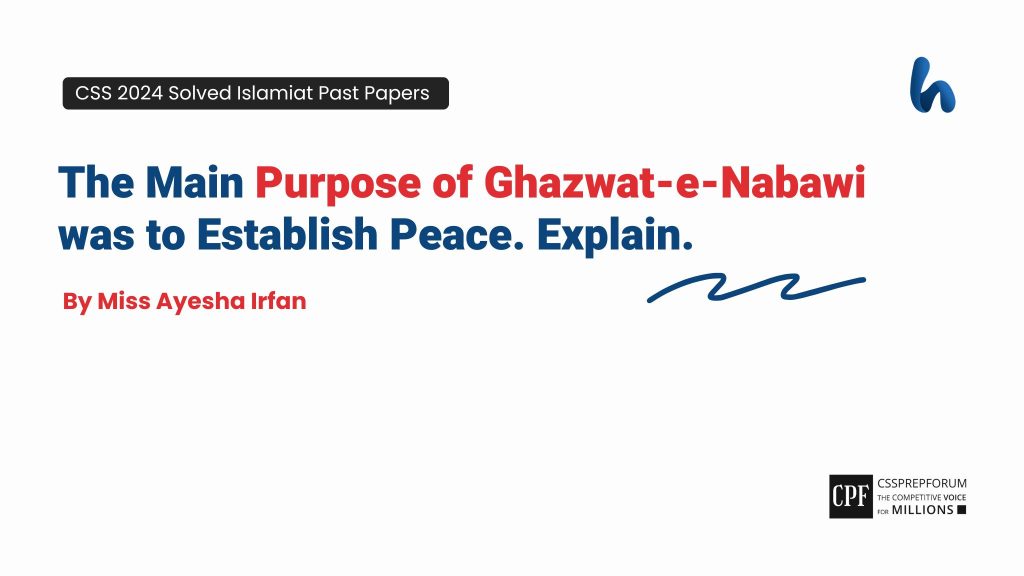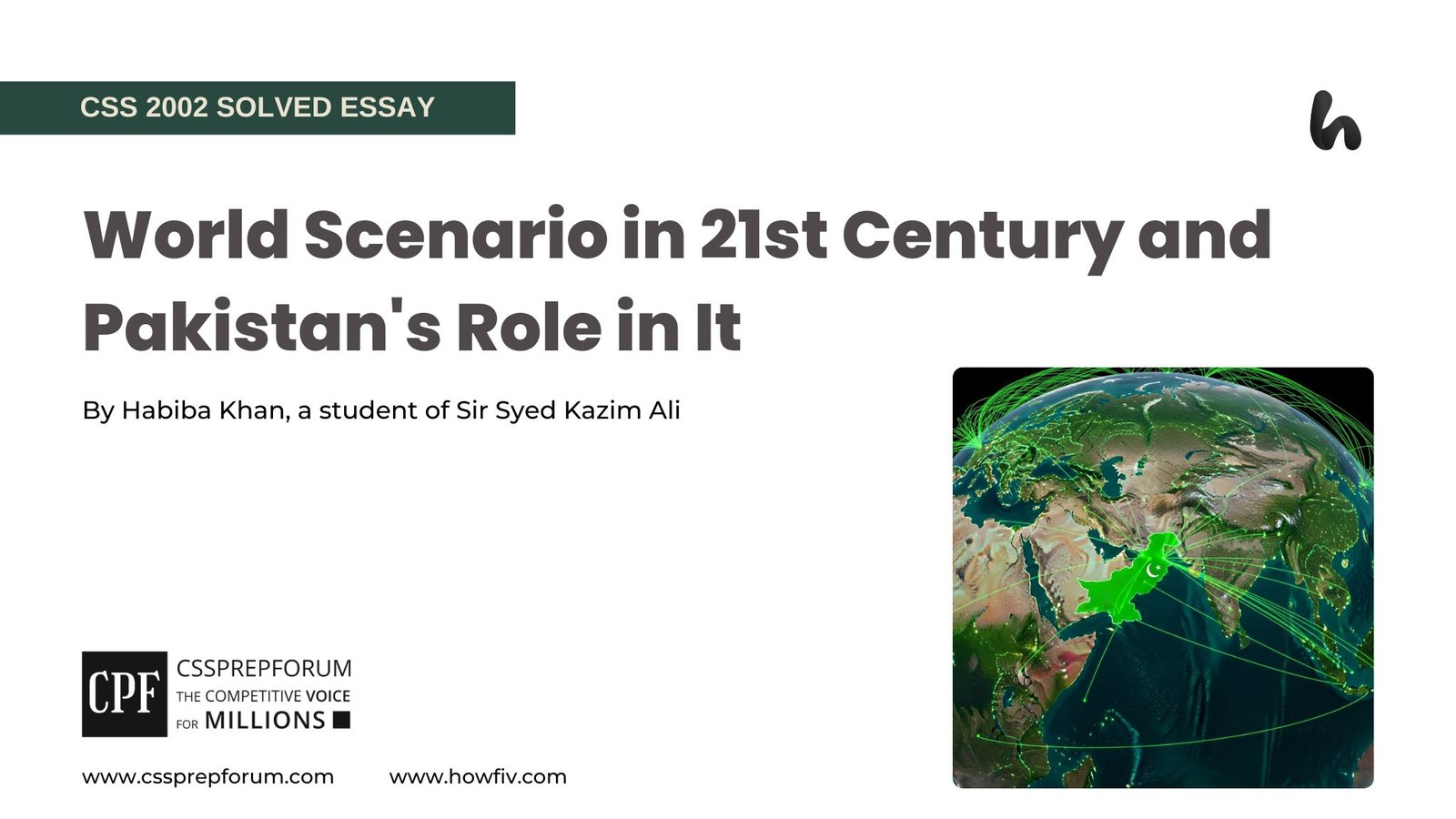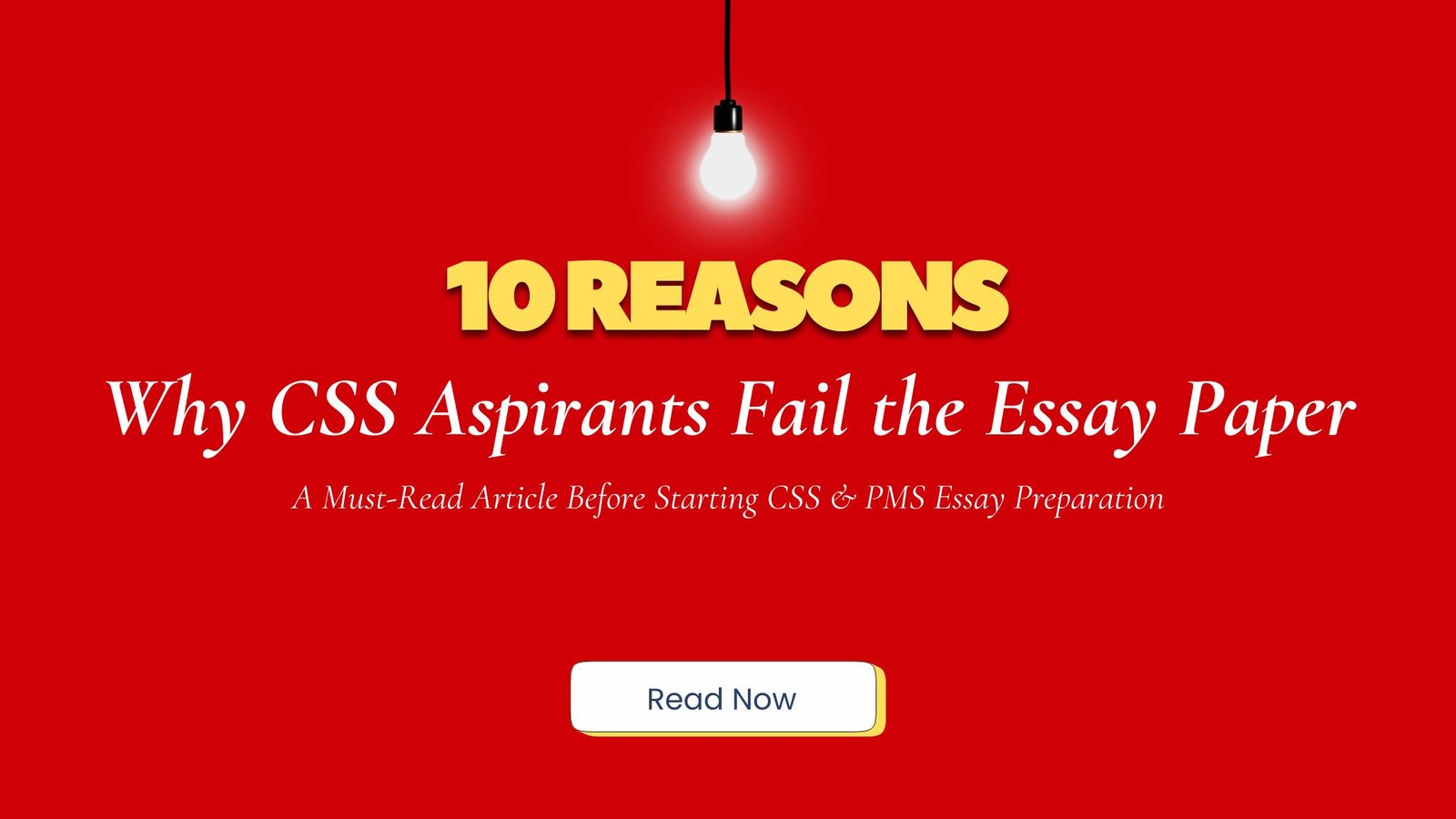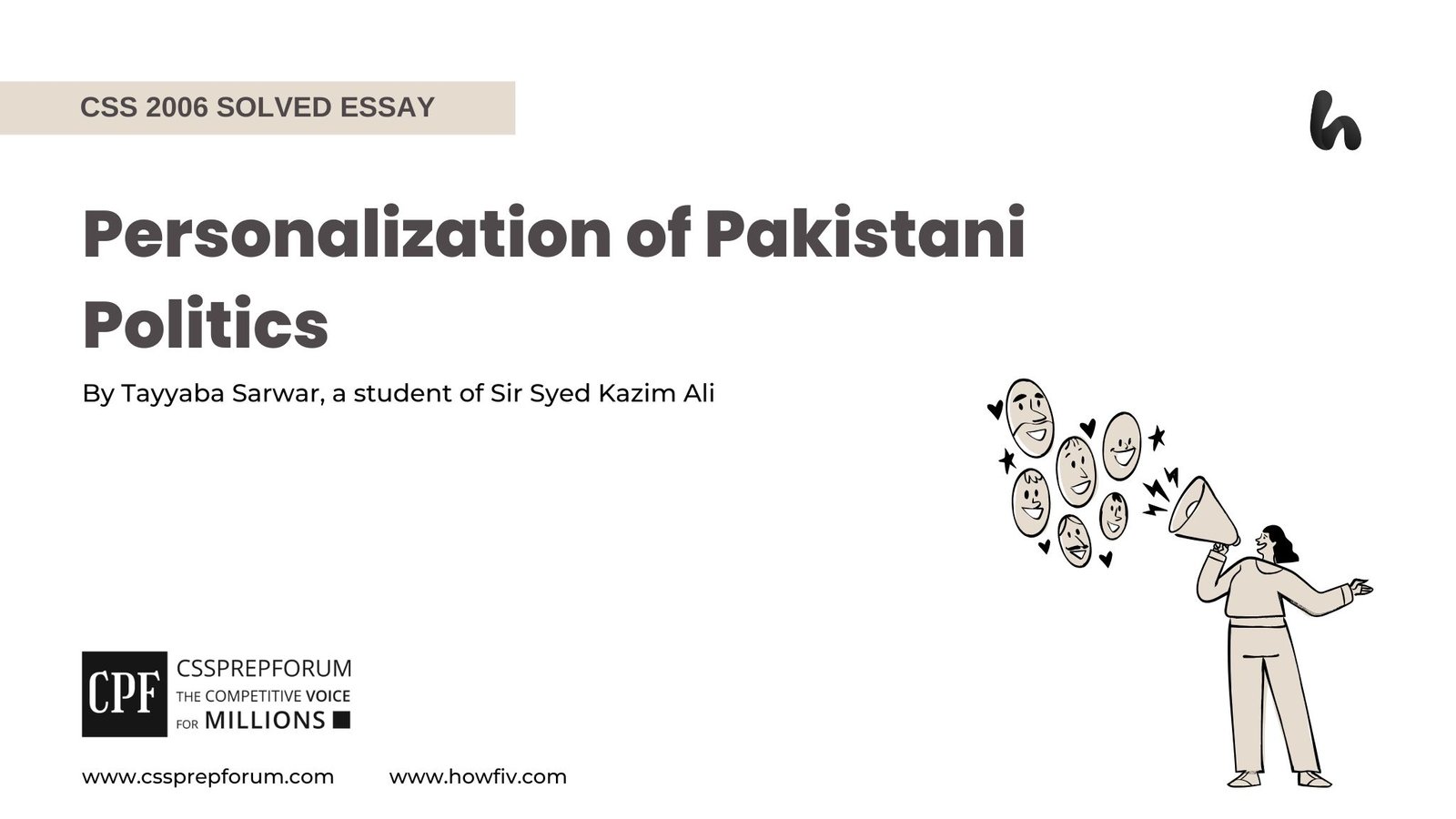CSS Solved Islamiat Past Papers | The Main Purpose of Ghazwat-e-Nabawi
The following question of Islamiat is solved by Miss Ayesha Irfan, the highest scorer in CSS Islamiat. Moreover, the question is attempted on the same pattern taught by Sir Syed Kazim Ali to his students, scoring the highest marks in compulsory subjects for years. This solved past paper question is uploaded to help aspirants understand how to crack a topic or question, how to write relevantly, what coherence is, and how to include and connect ideas, opinions, and suggestions to score the maximum.

Question Breakdown
In this particular question, the examiner asked for a proper explanation of Ghazwat-e-Nabawi’s primary goal, which was to establish peace. On the other hand, providing a summary of Ghazwat-e-Nabawi regulations is crucial to achieving high grades in Islamic studies. After addressing the central portion of the question with pertinent examples, act like a carry-on top. This section can be explained by citing the lessons and teachings of the Holy Prophet (PBUH) regarding every war.
Outline
1- Introduction
2- A bird’s eye view of the rules of Ghazwat-e-Nabawi
- ✓Strictly forbidden from hurting civilians—especially women, kids, and the elderly.
- ✓Treating prisoners fairly includes giving them food and shelter.
- ✓Strictly forbidden to loot during Ghazwat-e-Nabawi
- ✓Strictly prohibited from damaging the trees, particularly the fruit-bearing ones, And not burning crops with fire
- ✓Kill none of the enemy’s flock except for what you need to eat
3- The primary purpose of Ghazwat-e-Nabawi was to establish peace
3.1- The Holy Prophet’s (PBUH) establishing peace in Gazwa Badr
- ✓Conditions on prisoners of war
- ✓peaceful solutions to disputes
3.2- The Holy Prophet’s (PBUH) fostering peace in Gazwa Uhud
- ✓Pardoned to Hinda
3.3- The Holy Prophet’s (PBUH) establishment of peace in Gazwa Khandaq
- ✓ The idea to dig a trench saved many lives
- ✓Execution of Banu Saad and Banu Nazir because they broke the treaty
3.4- The Holy Prophet’s (PBUH) cultivating peace in Gazwa Khaybar
- ✓Formation of the Treaty of Hudaybiyyah
- ✓Bait of companions at Prophet’s hand
3.5- The Holy Prophet’s (PBUH) brought about peace in Fatah Mecca
- ✓Abu Sufyan’s home was declared a shelter by the Holy Prophet(PBUH)
- ✓Masjid declared safe places
- ✓The city was conquered without bloodshed
- ✓the sanctity of the Kaaba was respected
- ✓A general amnesty was announced
3.6- The Holy Prophet’s (PBUH) promoting peace in Gazwa Huniayn
- ✓The Prophet released many prisoners
- ✓He (PBUH) divided the war spoils among the victors and new Muslims
- ✓He gave 100 camels to each of them, as well as to Malik bin ‘Awf, whom he reappointed as chief of his people.
3.7- The Holy Prophet’s (PBUH) promoting peace during the siege of Taif
- ✓Kindness towards Taif residents
- ✓ceased burning Taif’s palm trees
4- Conclusion

Answer to the Question
1-Introduction
The word “Gazwa” means the battles that the Prophet Muhammad and his comrades fought in. These battles were fought to establish and uphold security, peace, and religious freedom rather than for the purpose of conquest or aggression. The Treaty of Hudaybiyyah is one well-known example of the Prophet’s efforts to maintain peace even in the midst of hostilities. Despite facing hostility and aggression from the Quraysh tribe of Mecca, the Prophet negotiated a peace treaty that allowed a cessation of hostilities and guaranteed Muslims freedom to practice their faith. In spite of the Quraysh Mecca’s animosity and aggression, the Prophet negotiated a peace treaty that allowed hostilities to end and guaranteed Muslims freedom to practice their faith. This peaceful resolution of disputes was an example of the Prophet’s dedication to upholding the principles of justice and tolerance. Furthermore, to establish permanent harmony in society, the Prophet strongly emphasized the importance of nonviolence, forgiveness, and reconciliation. In a nutshell, Ghazwat-e-Nabawi serves as an example of Islam’s emphasis on peace, justice, and reconciliation and emphasizes the Prophet’s persistent commitment to establishing peaceful coexistence and harmony in society.
“And the servants of the Most Merciful are those who walk upon the earth easily, and when the ignorant address them [harshly], they say [words of] peace”
(25:63)
2-A bird’s eye view of the rules of Ghazwat-e-Nabawi
Islam encourages harmony and peace among people, which is why it is frequently referred to as the religion of peace. Thus, the Prophet of God always preaches peace in all of his acts, even in times of war. Consequently, he forbade harming civilians, particularly women, children, and the elderly. Additionally, he commanded Muslims to treat prisoners fairly, which included providing them with food and shelter. Moreover, during Ghazwat-e-Nabawi, plundering and damaging trees, especially those that bore fruit, was strictly forbidden. Crops were also not to be burned. Last but not least, kill none of the enemy’s flock except for what they need to eat.
3-The primary purpose of Ghazwat-e-Nabawi was to establish peace
Ghazwat-e-Nabawi’s primary goals were to uphold Islamic teachings, promote peace, and protect the Muslim community. These conflicts were fought against those who wanted to harm Muslims or stop them from following their faith, with the goal of establishing peace and defending themselves.
- 3.1- The Holy Prophet’s (PBUH) establishing peace in Gazwa Badr
A notable instance from Muslim history that illustrates the idea that “victory is from Allah – it does not depend on numbers or collecting weapons and shields” is the Battle of Badr.“How often has a small group overcome a might host by Allah’s leave. And Allah is with the patient.” (Surah Al-Baqarah 2:249). Allah’s Messenger (S.A.W.) and his allies bravely fought until the Quraysh suffered severe casualties and abandoned the battleground with the aid of Allah. Seventy of their finest men were lost, and seventy more were captured by the Muslims. In this battle, only fourteen Muslims lost their lives. Therefore, the Quran says,
“And remember when you were few and were reckoned weak in the land and were afraid that men might kidnap you, but He provided a safe place for you, strengthened you with His help, and provided you with good things so that you might be grateful.” (Surah Anfal 8:26)
The Muslims united into a single, strong nation following the Battle of Badr. The necessity of finding peaceful solutions to disputes whenever possible is one of the most important lessons to be learned from the Battle of Badr. While some prisoners were executed for their prior crimes in Mecca, the others were given the choice to either convert to Islam and gain their freedom, pay a ransom, or teach ten Muslims to read and write. The Prophet Muhammad first tried to stay out of the way of the Quraysh and only went to war as a last resort. This teaches us the importance of peaceful conflict resolution, negotiation, and diplomacy in handling disagreements.
- 3.2- The Holy Prophet’s (PBUH) fostering peace in Gazwa Uhud
The Battle of Uhud, a significant event that marked a turning point in Islamic history, was brought to our attention during the month of Shawwal. After the Battle of Badr, this was the second battle in Islamic history.
“Yes, Allah did indeed fulfil His promise to you when you were about to destroy your enemy with His approval. However, you disregarded the order after He showed you the loot that you desired and flinched. There are those among you who long for this world and others who want the Hereafter. Did He then take you away from your enemies to put you to the test? However, He pardoned you since Allah is a gracious God to believers. (Al-Imran 3:152)
During the war, the Prophet (PBUH) urged that those guarding the exposed hill remain in their current positions nevertheless. Regretfully, they opened the door for a counterattack by leaving this precarious hill exposed once more to Muslim attack. And under Khalid Ibn Walid’s direction, the adversaries seized the chance. Even the Prophet (PBUH) himself suffered injuries in the Battle of Uhud, and there were numerous other incidents, such as the rumour that the Prophet (PBUH) was killed, that need to be examined. Very few people in this circumstance stuck around to keep the Prophet (PBUH) safe. Among them was Imam Ali (a.s), who received his own sword from the Prophet (PBUH) since his own was broken. At this moment, a voice rang out from the heavens, demanding: “There is no sword like Zulfiqar, and there is no warrior like Ali.” However, Wahshi Ibn Harb was the one who brutally killed Sayyidina Hamza in the Battle of Uhud, taking out his liver and giving it to Abu Sufiyan’s wife, Hinda, as a memento. They even dismembered his pure organs and wore them as necklaces around their necks. They brought sorrow for his uncle to the Prophet’s (S) tender heart.
وَإِنْ عَاقَبْتُمْ فَعَاقِبُوا بِمِثْلِ مَا عُوقِبْتُم بِهِ وَلَئِن صَبَرْتُمْ لَهُوَ خَيْرٌ لِّلصَّابِرِينَ
“And if you take a turn, then retaliate with the like of that with which you were afflicted; but if you are patient, it will certainly be best for those who are patient”
(16:126)
Therefore, the Holy Prophet (PBUH) forgave her and advised her to never again appear before him.
- 3.3-The Holy Prophet’s (PBUH) establishment of peace in Gazwa Khandaq
Amidst the ongoing war between the Muslims and the Quraysh, the Muslims defended their capital, Medina, by digging a trench within their settlement at Salman the Persian’s suggestion. This action was known as the Battle of the Trench, also known as the Battle of Khandaq and the Battle of the Confederates. The army was gathered at the hillock of Sala’, where Muhammad had established his military headquarters. If the enemy were to breach the trench, the Muslims would have the upper hand. The last 3,000 men, who included every Medina resident over 14, with the exception of the Banu Qurayza (who did provide the Muslims with some tools for trench digging), repelled the invasion and saved the city.
It is not harmful for a Muslim leader to take good advice from other Muslims. For example, Salman al Farsy came up with the idea to dig a trench (Khandaq). In order to keep the enemy forces from capturing women and children, the Prophet advised them to seek refuge in fortified homes and castles. Nonetheless, decisions regarding Muslim matters must be made through mutual consultations or shura. The Muslim army captured the Banu Qurayza tribe’s stronghold and belongings after they submitted. Sa’ad, who subsequently passed away from his combat injuries, issued the ruling that some of the fighters’ male members would be put to death, and their female members and children would be sold into slavery. Muhammad gave his approval to this choice, and the sentence was executed the following day. It is contended by scholars that Muhammad had already made up his mind regarding this ruling prior to the Qurayza’s capitulation and that Sa’ad was prioritizing the Muslim community over his tribe. However, the punishment was a reaction to the Qurayza’s actions, which were seen as acts of treason because they broke their agreement with Muhammad to defend the Muslims jointly and by providing support and encouragement to their enemies.
- 3.4-The Holy Prophet’s (PBUH) cultivating peace in Gazwa Khaybar
The Jewish community of Khaybar and the early Muslims engaged in armed combat in 628 CE, which is known as the Battle of Khaybar. The Jews of Khaybar were accused of organizing a plot to attack Medina by joining forces with the Arab tribe Ghatafan and Jewish tribes from Banu Wadi Qurra, Tayma, and Fadak. Because the Prophet explained to his companions his dream of circumambulating the Kaſba (ṭawāf), which set off the Ḥudaybiyya incident. It was against Arab custom for the Quraysh to attempt to stop the pilgrims from Medina, a rival state. Therefore, Both sides agreed to resolve the dispute diplomatically rather than militarily and exchanged ambassadors. Consequently, under certain conditions, a ten-year ceasefire agreement was signed. The peaceful settlement of the conflict between the Muslims and the Jewish tribe of Khaybar is referenced in the Gazwa Khaybar as the lesson of peace. The Prophet Muhammad worked with the tribe to negotiate a peace treaty that allowed them to keep their land and coexist peacefully with the Muslim community rather than using force.
The Hudaybiyya peace treaty represents a significant turning point in the history of Islam. It is the prophetic government’s most important treaty. This agreement fostered a peaceful environment that facilitated Islam’s quick expansion throughout the Arabian Peninsula.
- 3.5-The Holy Prophet’s (PBUH) brought about peace in Fatah Mecca
A stipulation of the Hudaybiyyah Treaty permitted any tribe situated beyond Makkah or Madinah to elect to form an alliance with either the Quraysh or the believers. While Banu Bakr chose to support the Quraysh, Banu Khuza’ah sided with the Muslims and converted to Islam. Two years later, the Quraysh had not only broken the treaty by helping Banu Bakr against Banu Khuza’ah in secret, but they had also contributed to the deaths of twenty Muslims, one of whom had run away and taken sanctuary in the Ka’bah’s sacred area. The sacredness of Allah’s House had been violated, and the treaty was broken. Then the great Fatah Makah happened, and before the Muslims entered Makkah, the Prophet (saw) told Abu Sufyan that anyone who sought refuge in their homes or at the Sacred Masjid would be safe. The city was conquered without bloodshed, and the sanctity of the Ka’bah was respected. The Prophet (saw) then addressed those who had oppressed, slandered, and killed his companions. He asked them what they thought he would do with them, and they said, “You are our noble brother, son of our noble brother!” We expect nothing but good from you. The Prophet (saw) said, ‘I say to you as Yusuf (Joseph) said to his brothers,
“There is no blame on you today. Allah will forgive you, as He is the Most Merciful of the Merciful.”
[12:92]
In another story, the Prophet (saw) told them, ‘Go, you are free.’
The Prophet (saw) even forgave Hind bint Utbah, who plotted to murder his beloved uncle Hamzah (ra) at the Battle of Uhud. The Conquest of Makkah was a day of mercy and forgiveness. The people all accepted Islam.
- 3.6-The Holy Prophet’s (PBUH) promoting peace in Gazwa Huniayn
The phenomenal victory of Islam over the Quraish and the massive conversions to Islam during the conquest of Makkah astounded the disbelievers and led many tribes to Islam. The Quraish had become undisputed champions of paganism after submitting to Islam’s rising power. They began to harbour hopes of bringing the Muslims to their knees and gaining fame from the Quraish’s declining prestige. So they conspired with other pagan leaders and decided to fight Muslims under the command of Malik bin ‘Awf in the month of Shawwal, the eighth of the Islamic calendar year. Although the Muslims suffered a temporary defeat at the start of the Battle of Hunain, they eventually won decisively.
Allah forgives the rest of Hawazin for embracing Islam and visiting the Prophet before he arrived in Makkah in the Ji’ranah area. This happened twenty days after the Battle of Hunain. He gave them the option of taking their families who were prisoners or the war spoils they had lost, and they chose the former. The Prophet released many prisoners but divided the war spoils among the victors and new Muslims. He gave 100 camels to each of them, as well as to Malik bin ‘Awf, whom he reappointed as chief of his people. Ibn ‘Awf praised him for his courage and generosity.
- 3.7-The Holy Prophet’s (PBUH) promoting peace during the siege of Taif
The Prophet (peace be upon him) gathered the spoils and captives from the Battle of Hunayn and assigned Budeel ibn Waraqa and a group of Muslims to guard them after Allah gave His slaves of Muslims the victory at Hanayn, under the leadership of the Prophet, against their enemies from the rebelling tribes led by the tribes of Thaqeef and Hawazin. Then, with peace upon him, he commanded the army to march on Taif, the refuge of Malik ibn Auf’s remaining disbelievers. Gates were the only way to enter the fortified city of Taif. The Taif people were extremely wealthy and had a great deal of war experience, which allowed them to build some of the most formidable forts.
Salman the Persian (may Allah be pleased with him) advised the Prophet (peace be upon him) to use catapults since the Persians had been using them in their battles. This made the Prophet the first Arab to do so.
One device that can throw stones very far is the catapult. Because of the protracted siege of Taif and the Thaqeef tribe’s refusal to abandon their forts, the Prophet (peace be upon him) began to use the catapult. This was due to the fact that they had an abundance of supplies and an impregnable fortified city
(The Wars by Al-Waqadi, page#927).
Despite their failure to free the walled city, the Muslims emerged victorious. Twelve Muslims lost their lives as a result of the siege of Taif, and numerous others suffered injuries as a result of the attacks by Taif residents. The Prophet’s (peace be upon him) forgiveness and kindness were the most crucial lessons learned during this siege. In an attempt to bring them back to reason, the Prophet (peace be upon him) actually lifted the blockade of their forts and ceased burning their palm trees.
Conclusion
Ghazwat-e-Nabawi’s primary objectives were to defend the Muslim community from external threats and to establish justice and peace on the Arabian Peninsula. These wars were fought on the defensive in an effort to protect the Muslim community from harm and persecution. Take the Holy Prophet’s (PBUH) terms for prisoners of war and peaceful dispute resolution, which led to the establishment of peace in Gazwa Badr. The promotion of peace in Gazwa Uhud by the Holy Prophet (PBUH) was pardoned to Hinda. The Holy Prophet (PBUH) decided to dig trenches in Gazwa Khandaq, which protected many lives during the war. The establishment of the Hudaybiyyah treaty at Gazwa Khaybar was one of the ways the Prophet Muhammad (PBUH) promoted regional peace. During Fatah Makkah, he declared the Masjid and Abu Sufyan’s home to be safe havens. As a result, the city was captured without a single casualty. The sanctity of the Kaaba was maintained, and a general amnesty was declared. To bring about peace in Gazwa Huniayn, the Holy Prophet (PBUH) freed many prisoners, divided the war booty among the victorious and newly converted Muslims, and gave 100 camels to each of them. Therefore, It has been demonstrated that establishing peace was Ghazwat-e-Nabawi’s primary goal.
CSS 2024 Solved Islamiat

Searching for CSS or PMS Solved Islamiat Past Papers?
Are you preparing for CSS or PMS and searching for solved Islamiat past papers, notes, books, PDFs, and MCQs? Explore them for free on Howtests and Cssprepforum. All content is fully solved and written by Miss Ayesha Irfan. For your convenience, the links are provided below, simply click on any to start reading and preparing.












